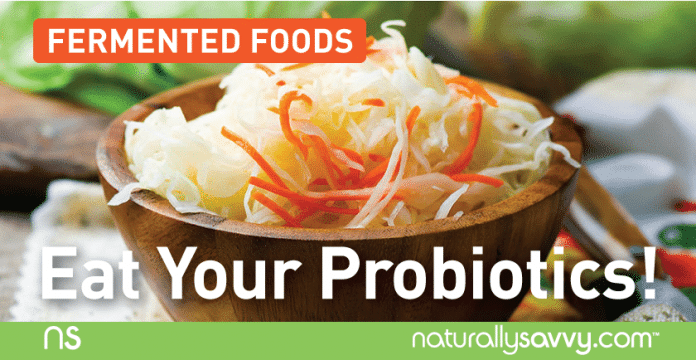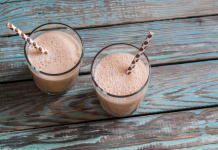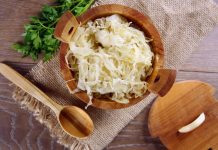
A probiotic is a friendly, live bacteria that is found in our intestinal ecosystem. In Greek, the term probiotic translates to mean “promoting life.” Therefore we should take probiotics regularly to help promote a healthy life.
Long before supplementation, civilizations preserved foods through the process of fermentation and began to value the health benefits that resulted after consuming these special foods. They may not have known it then, but it was the hard work of billions of beneficial probiotic bacteria created by the fermentation of foods that were keeping them healthy and strong. Fermented foods existed in all cultures in various forms. Today, many cultures still carry on with these traditional foods while some other cultures, particularly the Western Civilization, does not.
We have a battle going on inside of each one of us, with a strong army that works in our defense. Our war wages with team “good bacteria” versus team “bad bacteria.” Consuming fermented foods that contain living lacto-bacteria protects us from the proliferation of harmful pathogenic bacteria.
When the good outweighs the bad, we maintain a healthy constitution because beneficial bacteria promotes proper digestion, a strong immune system, and aids in assimilation of nutrients from our food and supplements, in particular B vitamins and omega-3 fatty acids. If that isn’t enough to convince you, probiotics also create metabolic byproducts after breaking down sugars that fuel our intestinal cells, keeping them strong and functioning optimally.
Read more about fermenting foods at home
When looking to incorporate fermented foods into your diet, make sure that the product has not been heated or pasteurized. Bacteria do not easily survive extreme measures as they are quite delicate, so if you need to heat a probiotic-rich food, do so gently at low temperatures. Listed below are a number of foods that can be found in your health foods store or grocery store. The great thing is a mere couple of tablespoons a day will do ya! You may not love the taste but they can easily be mixed into your meals unnoticed.
Natto
Just as the Australians have vegemite, the Japanese have natto. Its cover is a sticky web-like paste and smelly but the Japanese people swear by it! These fermented soybeans are used as a condiment with a meal. An excellent protein-rich food but is an acquired taste for sure!
Kimchi
Korea’s best known food and served with every meal. Kimchi is a very spicy fermented condiment made from various vegetables but most commonly, napa cabbage. Once you have gotten a taste for it, you will begin to absolutely crave it! Find it at an Asian market or enjoy it at a Korean restaurant.
Miso
Another import from Japan, miso is a very salty paste with the texture of a nut butter. It is made from fermented soybeans, rice, barley or wheat. There are many different types; red, white, brown and the aging time and flavor also varies. It is commonly served at sushi restaurants as a soup. It can be used in soups, on sandwiches, and in dressings or marinades.
Tempeh
An Indonesian staple for over 2000 years, tempeh is a cake-like compound of fermented soybeans that tastes nutty and cheesy and is an excellent meat replacement due to its high protein content. It easily absorbs marinades and can be used in stir-fries, on sandwiches, in soups, in spaghetti sauce, in chili and more. There are websites dedicated to its amazing versatility!
Sauerkraut
A German favorite, translated meaning “sour cabbage.” This pickled cabbage is generally a hit at Oktoberfests around the world on a large sausage or along side a few perogies. The benefits of raw cabbage are numerous, particularly in regards to cancer. Make sure your sauerkraut is raw and unpasteurized so that the beneficial enzymes and bacteria are present. If you are buying store-bought, look for sauerkraut in the refrigerated section of your supermarket or natural health store.
Kefir
A cultured milk product and one of the healthiest probiotic beverages you can drink. You can easily make your own Kefir from real, certified, live kefir grains and organic milk. There is a real mystery about the kefir grains and where they originally come from. They are considered extremely precious and trace back thousands of years to the native population of the Caucasus Mountains. You can also purchase kefir beverages. For those who are lactose intolerant, coconut kefir is now becoming available at some natural foods store.
Read more about the healthy benefits of probiotics
Kombucha
A medicinal fermented black, green or white tea with a slight wine-like taste. It has been drunk for thousands of years for its many benefits, and is becoming widely available and more popular in North America. Look for it at your natural foods store or specialty market in the refrigerated section.
Bio-K+ (available dairy and dairy-free)
Bio-K+ is a fermented beverage found in health foods stores everywhere that contains specific stains of beneficial bacteria. They are available in convenient, individual bottles that can be consumed in one to two easy gulps!
Let’s bring tradition and internal health back to the table!
References:The Clear Skin Die ![]() , Logan, A., Trelor, V. 2007
, Logan, A., Trelor, V. 2007
Selection Criteria of Probiotics for Use in Food Products: How Should Bacteria Strains be Chosen? Fumiaki, A. 2010
Fermented foods and Gut Health










